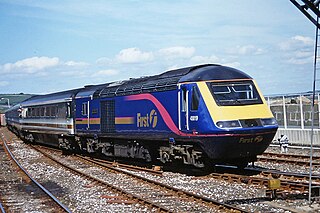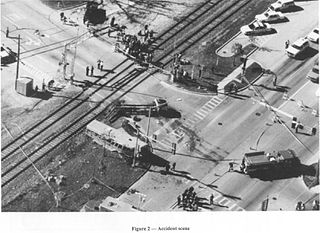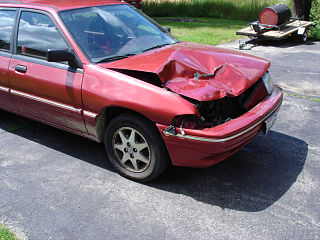Different methods of transportation in South Africa include roads, railways, airports, water, and pipelines for petroleum oil. The majority of people in South Africa use informal minibus taxis as their main mode of transport. BRT has been implemented in some South African cities in an attempt to provide more formalised and safer public transport services. These systems have been widely criticised due to their large capital and operating costs. A "freeway" is different from most countries as certain things are forbidden which include certain motorcycles, no hand signals, and motor tricycles. South Africa has many major ports including Cape Town, Durban, and Port Elizabeth that allow ships and other boats to pass through, some carrying passengers and some carrying petroleum tankers.

Automotive safety is the study and practice of automotive design, construction, equipment and regulation to minimize the occurrence and consequences of traffic collisions involving motor vehicles. Road traffic safety more broadly includes roadway design.

Road traffic safety refers to the methods and measures used to prevent road users from being killed or seriously injured. Typical road users include pedestrians, cyclists, motorists, vehicle passengers, horse riders, and passengers of on-road public transport.

Rumble strips are a road safety feature to alert inattentive drivers of potential danger, by causing a tactile vibration and audible rumbling transmitted through the wheels into the vehicle interior. A rumble strip is applied along the direction of travel following an edgeline or centerline, to alert drivers when they drift from their lane. Rumble strips may also be installed in a series across the direction of travel, to warn drivers of a stop or slowdown ahead, or of an approaching danger spot.

An advanced driver-assistance system (ADAS) includes technologies that assist drivers with the safe operation of a vehicle. Through a human-machine interface, ADAS increases car and road safety. ADAS uses automated technology, such as sensors and cameras, to detect nearby obstacles or driver errors, and respond accordingly. ADAS can enable various levels of autonomous driving.

The Ufton Nervet rail crash occurred on 6 November 2004 when a train collided with a stationary car on a level crossing on the Reading–Taunton line near Ufton Nervet, Berkshire, England. The collision derailed the train, and seven people—including the drivers of the train and the car—were killed.

The 1995 Fox River Grove bus–train collision was a grade crossing collision that killed seven students riding aboard a school bus in Fox River Grove, Illinois, on the morning of October 25, 1995. The school bus, driven by a substitute driver, was stopped at a traffic light with the rearmost portion extending onto a portion of the railroad tracks when it was struck by a Metra Union Pacific / Northwest Line train en route to Chicago.

Stagecoach Lincolnshire is a bus company, formerly known as Lincolnshire RoadCar, which runs services throughout Lincolnshire.

Bicycle safety is the use of road traffic safety practices to reduce risk associated with cycling. Risk can be defined as the number of incidents occurring for a given amount of cycling. Some of this subject matter is hotly debated: for example, which types of cycling environment or cycling infrastructure is safest for cyclists. The merits of obeying the traffic laws and using bicycle lighting at night are less controversial. Wearing a bicycle helmet may reduce the chance of head injury in the event of a crash.

Ingoldmells is a coastal village, civil parish and resort in the East Lindsey district of Lincolnshire, England. It is situated on the A52, and 3 miles (5 km) north from the resort town of Skegness.
On the 18th of November 1993, just after midnight, a minibus was involved in a fatal collision with a maintenance vehicle on the M40 motorway near Warwick, England. The minibus was transporting 14 children home to Worcestershire from a school trip to the Royal Albert Hall in London when it veered into the rear of the motorway maintenance lorry which was stationary on the hard shoulder. Twelve of the 14 children and their teacher who was driving died in the crash, which is one of the worst on the British road network. The two survivors sustained minor injuries, as did the people in the motorway maintenance lorry.

A collision avoidance system (CAS), also known as a pre-crash system, forward collision warning system (FCW), or collision mitigation system, is an advanced driver-assistance system designed to prevent or reduce the severity of a collision. In its basic form, a forward collision warning system monitors a vehicle's speed, the speed of the vehicle in front of it, and the distance between the vehicles, so that it can provide a warning to the driver if the vehicles get too close, potentially helping to avoid a crash. Various technologies and sensors that are used include radar (all-weather) and sometimes laser (LIDAR) and cameras to detect an imminent crash. GPS sensors can detect fixed dangers such as approaching stop signs through a location database. Pedestrian detection can also be a feature of these types of systems.

Road traffic collisions generally fall into one of five common types:

A traffic collision, also called a motor vehicle collision, occurs when a vehicle collides with another vehicle, pedestrian, animal, road debris, or other moving or stationary obstruction, such as a tree, pole or building. Traffic collisions often result in injury, disability, death, and property damage as well as financial costs to both society and the individuals involved. Road transport is the most dangerous situation people deal with on a daily basis, but casualty figures from such incidents attract less media attention than other, less frequent types of tragedy. The commonly used term car accident is increasingly falling out of favor with many government departments and organizations, with the Associated Press style guide recommending caution before using the term. Some collisions are intentional vehicle-ramming attacks, staged crashes, vehicular homicide or vehicular suicide.

On 22 December 2014 a bin lorry collided with pedestrians in the city centre of Glasgow, Scotland, killing six and injuring fifteen others. The driver of the council-owned vehicle, Harry Clarke, said he had passed out at the wheel. A similar blackout had happened to him in the driving seat of a bus. He had not disclosed that incident on his heavy goods vehicle licence renewal application, despite such self-reporting being mandatory. Clarke was officially told he would not face further prosecution, causing protests from victims' families at the way the case had been handled.
The death of Elaine Herzberg was the first recorded case of a pedestrian fatality involving a self-driving car, after a collision that occurred late in the evening of March 18, 2018. Herzberg was pushing a bicycle across a four-lane road in Tempe, Arizona, United States, when she was struck by an Uber test vehicle, which was operating in self-drive mode with a human safety backup driver sitting in the driving seat. Herzberg was taken to the local hospital where she died of her injuries.

The 2019 Totnes bus crash was a single-vehicle collision on the A385 road at Berry Pomeroy, Devon, England on 5 October 2019. More than 50 people – including the driver – were injured when a double-decker bus overturned at high speed between Totnes and Paignton. Eight passengers suffered injuries described as "serious" out of 37 requiring hospitalisation; though there were no fatalities.
















